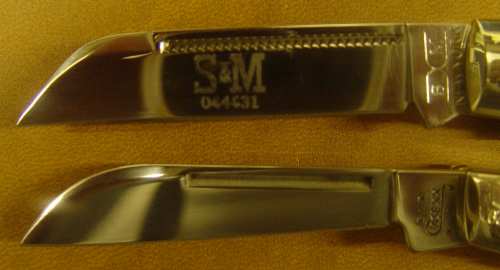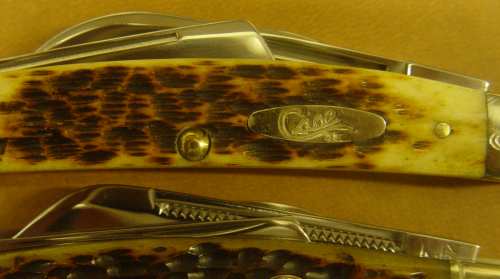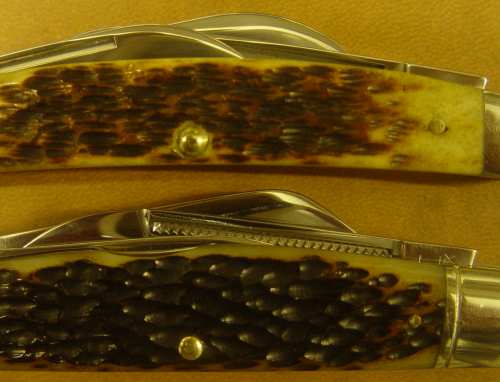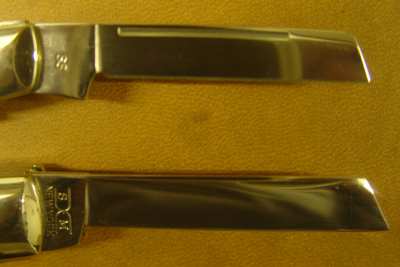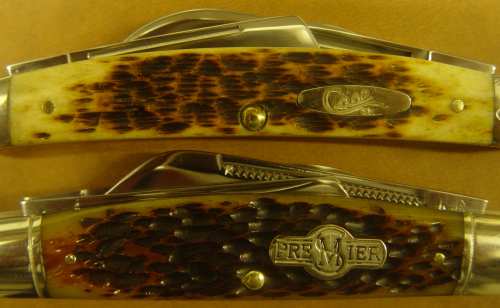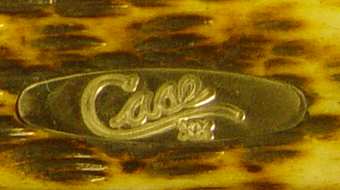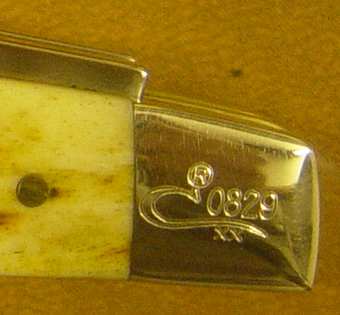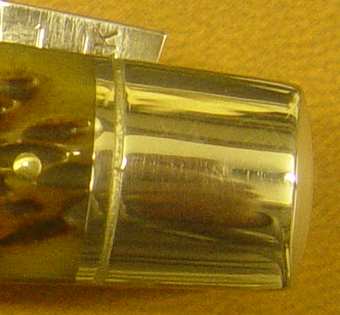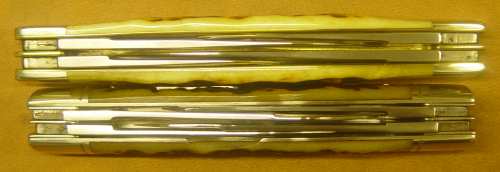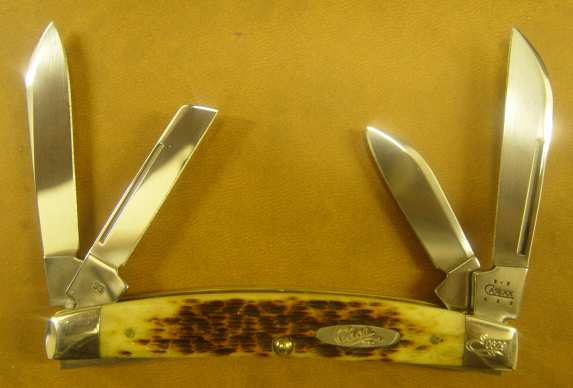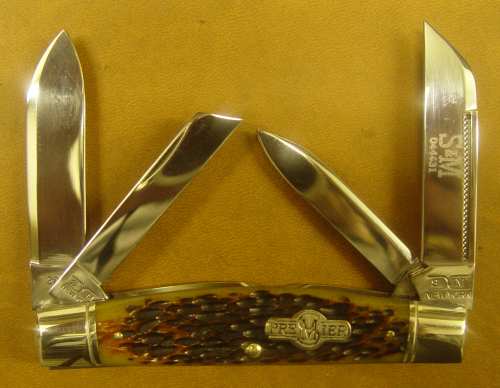ROUND 1 Points are scored here on the general "wow" factor and first impressions |
|||||||||||||||||||||||||||||||||
CASE 88 |
points | points | SCHATT & MORGAN |
||||||||||||||||||||||||||||||
|
|
||||||||||||||||||||||||||||||||
| The Case 88 comes into the ring somewhat skinnier than the Schatt, although a 1/4" longer. Standing alone he looks pretty impressive.... until the Schatt walks into the ring. | 6 |
9 |
Immediately, the Schatt & Morgan gives the impression of being a
chunkier knife than the Case. He certainly wins out on the "handsome" factor,
and looks as if he can do the business too.
|
||||||||||||||||||||||||||||||
Specifications
|
Specifications
|
||||||||||||||||||||||||||||||||
Blade length (measured from the bolster):
|
Blade length (measured from the bolster):
|
||||||||||||||||||||||||||||||||
ROUND 2 We'll match them up. Standing side by side |
|||||||||||||||||||||||||||||||||
The Master Sheepsfoot Blade
S&M (top) 2-5/8" They stand equal in length, but the Schatt & Morgan blade is much deeper and even throughout its length. The Case knife's blade narrows towards the tang, which gives it a weaker appearance. The Case blade has a top grind that runs back about half its length and gradually tapering out to nothing, whereas the Schatt & Morgan's top grind is a little deeper into the blade and ends just forward of the nail nick with a really neat corner. (On the back of the blade, the Schatt & Morgan's top grind runs right back to the tang, whereas on the Case it runs back about half the length of the blade, gradually tapering out to nothing. Just a cosmetic feature). The tang, at its deepest point, is 1/2" on the Case, and 5/8" on the Schatt & Morgan. The nail nicks on both are "long pull", but the Schatt & Morgan wins out with the "match strike" nail nick. The Schatt & Morgan knife has the "Queen Cut. Co. Titusville PA" stamp on the rear of the tang on this blade, showing where it was made. Interestingly, although it is a "Schatt & Morgan Premier" series knife, it has a box with "New York Cutlery Co" as the main logo on the box, (together with "J,W. Schatt - C.B. Morgan"), The "S&M New York" tang stamp, and "Queen Cutlery Co." on the box and rear tang stamp. A real mix of identities that I haven't seen on other Schatt & Morgan knives. There's something that I don't like about the Schatt & Morgan blade, and that's the etching of the large S&M and the pattern number. For a start, the etch isn't good. Its uneven and "blotchy" as if the etching hasn't worked properly, and secondly (and this is just personal preference), I think that blade etchings like this are unnecessary and unsightly. Heck.... it has the "S&M" mark on the tang doesn't it? I'm going to give the Schatt & Morgan some serious negative penalty points for that poor blade etch.
In the closed position, there is quite a noticeable difference in the "sit" of the master blade. On the Case, although the long pull nail nick is 1" long, much of that length is obscured by the coping blade, and therefore there is no real advantage in having the "long pull", as there is only 1-1/2" of leverage from the pivot point of the blade. That makes it a little harder to open the blade against the strength of its spring. On the other hand, the nail nick on the Schatt and Morgan extends beyond the coping blade, making it much easier to open, with much more leverage.
|
The Master Spear Blade
S&M (top) 2-1/2" Again, the blades are equal in length on both knives, and it is pretty obvious which one is the deeper blade. Again, the Case blade appears to be weaker at the ankle as it tapers back towards the tang, where it is just 5/16". It makes little difference in reality, but that Schatt & Morgan blade just looks more up to the task with an even depth of 9/16". Personal opinion, but that Schatt blade is really impressive, and the one that you'll use the most. Let's also look at the closed position of that blade on each knife.
Again, the Schatt & Morgan has a better design, with the full length of its match strike nail nick accessible, due to the lower "sit" of the blade in front of it. That makes it much easier to open than the Case knife, with a longer leverage.
|
||||||||||||||||||||||||||||||||
The Coping Blade
Case (top) 2" Not much to choose between them, although the Schatt & Morgan's is 1/4" longer. The Case has a long pull nail nick, and the Schatt & Morgan has a standard nail nick. There's a reason for this, and its down to the design of the low "sit" of the Schatt & Morgan's coping blade when it is closed. Furthermore, that low sit is because it is designed to be clear of the master blade behind it, so that the master blade can be opened more easily. Clever design, which gave thought to the knife as a whole. Notice in the photo below how the Case knife's coping blade (at the front) sits higher in its closed position. It is easy to open, but it obscures part of the nail nick on the master blade, whereas the Schatt & Morgan knife is more carefully thought out.
Before we leave the blades, there are a couple of other things worthy of mention. All the blades on both knives have half stops, which is a nice feature. There is no blade rub on either of these knives. The most important factor, however, is the steel used for the blades. The Case knife uses their standard "stainless steel", whereas the Schatt & Morgan has blades of 420HC - a steel preferred by those who use their knives. For me, that certainly gives the Schatt & Morgan the advantage. Sharpness out of the box? Neither were "shaving sharp", but the Case knife was certainly the sharper of the two. I don't consider that a big deal though, as both would need to be sharpened pretty soon anyway. Hey! you are going to use your knife aren't you? I suspect that most people who buy this Case knife will put it away as a collector's item, whereas many more of the Schatt & Morgans will be used.
|
The Pen Blade
Case (top) 1-7/8" There's a big noticeable difference in the two knives when one compares this blade. Actually, I quite like the unusual dumpy shape of the Case blade, whereas the Schatt & Morgan's is more of a traditional blade shape. As with the coping blade, the Case knife has a long pull nail nick, and the Schatt & Morgan's a standard nail nick. And yet again, the difference comes down to the integrated design of the Schatt & Morgan when the blades are closed. Note how that on the Case knife, the pen blade sits really quite high, and obscures much of the nail nick on the blade behind it. In contrast, the pen blade on the Schatt & Morgan sits very low to leave full access to the nail nick on the blade behind it. So low in fact, that there is a small cut-out in the upper edge of the handle & liners to get at the small blade's nail nick. Integrated design cleverly thought out. Extra points for the Schatt & Morgan. It is little things like this that are starting to make the difference between the two knives.
It is interesting to note that although the Case knife is 1/4" longer overall than the Schatt & Morgan, the latter packs larger blades. A negative point for the Schatt & Morgan. As with all knives made in the Queen factory in Titusville, the exposed tail end of the tangs have very sharp uncomfortable corners! They are going to put holes in your pockets. I wonder why they don't take the hint that we prefer them to be softer on those corners? (The solution to this, folks, is to mask off the bolsters to protect them, and then carefully stone those corners to a slightly rounded shape).
|
||||||||||||||||||||||||||||||||
ROUND 3
|
|||||||||||||||||||||||||||||||||
CASE 88 |
points | points | SCHATT & MORGAN |
||||||||||||||||||||||||||||||
The linersThe liners on the Case knife are of brass. There's nothing wrong with that. |
5 |
10 |
The linersOn the Schatt & Morgan knife the liners are of nickel silver. Yes! we like nickel silver. Bonus of 10 points for that. |
||||||||||||||||||||||||||||||
Handle Shape and ComfortThe handle on the Case Congress is long and lean looking. 9/16" at the widest point, tapering down to 1/2" wide at the bolsters. It has a much more pronounced curve than the Schatt & Morgan. It is here that I shall mention that the extra curvature makes this knife somewhat uncomfortable in the hand. With any blade open, and the knife held in a normal position for cutting, the back end of the handle digs sharply into the back of your palm. That isn't helped by the sharp corners on the back end of the bolsters. I gave both knives to my wife in their open position, and asked her which one she would prefer to use in the kitchen. She said immediately that the Case knife would hurt. And she's right. It would. That accentuated "congress curve" doesn't work too well for comfortable handling. Furthermore, the high protruding top corner of the coping blade (when closed) also digs into your middle finger. There are none of those problems with the Schatt & Morgan knife |
3 |
7 |
Handle Shape and ComfortThe Schatt & Morgan knife has wider handles. 3/4" (12/16") at the centre, and tapering down to 5/8" at the bolsters. There's much more meat in them, and they are more comfortable to the hand. The shallower "congress curve" is much more comfortable overall.
|
||||||||||||||||||||||||||||||
Bone handle scalesThere's nothing to fault with the jigged bone scales on the Case knife. Everything is positive, from the gorgeous natural colour to the well-worked jigging. A dark creamy coloured base, with rusty brown and terra cotta shades in the jigging. Lovely. |
9 |
9 |
Bone handle scalesThe bone on the Schatt & Morgan knife has a somewhat translucent natural look to it, with dark brown in the jigging, and a few hints of dark orange. Its hard to choose between the two knives, but my personal preference goes to the Schatt & Morgan. |
||||||||||||||||||||||||||||||
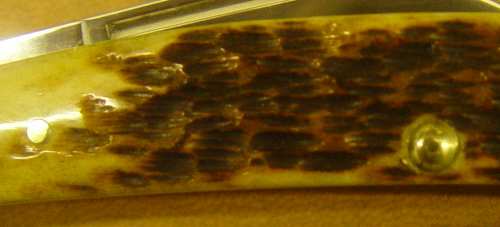 |
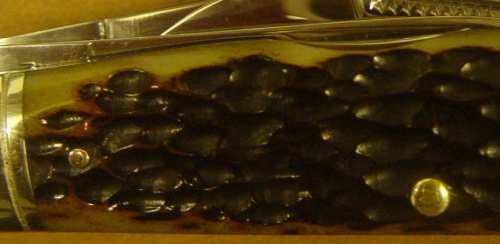 |
||||||||||||||||||||||||||||||||
Handle & Pivot PinsThe handle and pivot pins are of brass. The centre pivot pin on the Case knife is somewhat large (unnecessarily so?) and certainly enough to take something away from the overall look of the handles. |
7 |
10 |
Handle & Pivot PinsThe handle and pivot pins are of nickel silver. Not that they really make any real difference, but that metal is more aesthetically pleasing. The handle pins are of a smaller diameter than on the Case knife. The big difference is in the size of the pivot pin - which is much smaller in the Schatt & Morgan knife. It looks neater and is less obtrusive. |
||||||||||||||||||||||||||||||
The Shield
|
The Shield
|
||||||||||||||||||||||||||||||||
Bolsters
The nickel silver bolsters of the Case knife are small and slender, and are proportionally dead right to the shape and size of the handle. This particular knife is 1 of 1000 Limited Edition, and shows the official Case long tailed C and serial number engraved in the bolster. |
Bolsters
The nickel silver bolsters of the Schatt & Morgan knife are much more meaty. They have the "extra touch" of a milled line, which adds that extra bit of class. This Schatt & Morgan is a limited production knife, 1 of 350, although there is nothing on the knife to identify it as such. (The box label states "Exclusive Limited Production 1 of 350"). Generally speaking, most S&M knives are of a relatively small production run compared to Case, and some have only 50 made. |
||||||||||||||||||||||||||||||||
ROUND 4
|
|||||||||||||||||||||||||||||||||
CASE 88 |
SCHATT & MORGAN |
||||||||||||||||||||||||||||||||
| Everything fits together pretty well. As good as it gets for a
production knife.
If you hold it up to the light, looking at the side with the backsprings, then there are a couple of places between the liners and springs where you can see light. Having said that, this is pretty normal on a long knife. There are no signs of blades rubbing against each other. Smaller multi-blade knives often have this problem, but with the large Congress, there's plenty of space in there. So we're dead equal points on fit. |
Everything fits together pretty well. As good as it gets for a
production knife.
If you hold it up to the light, looking at the side with the backsprings, then there are a couple of places between the liners and springs where you can see light. Having said that, this is pretty normal on a long knife. There are no signs of blades rubbing against each other. So we're dead equal points on fit. |
||||||||||||||||||||||||||||||||
| The finish is pretty impeccable on the Case knife.
It has been well polished, and there are no signs of remaining grind marks or scratches. Overall, if anything, it is a little "over polished", as the edges and corners are what I would describe as "soggy" rather than neatly precise. (But to be fair, that's comparing it with a really high quality custom made knife).
|
8 |
8 but -10 for the bad parts |
The finish is extremely good on the Schatt & Morgan knife.
With a couple of exceptions: I really dislike those sharp corners on the back of the tang on each blade. The Case knives never suffer from that problem. Looking at the back of the knife, the backsprings, liners and the edges of the bolsters exhibit some scratch marks left over from filing/grinding. That's a pity, but they are noticeable, and they detract from what is otherwise an excellent knife.
|
||||||||||||||||||||||||||||||
|
|
|
|
|
||||||||||||||||||||||||||||||
Cost:
Schatt & Morgan $84.00 Investment Value:The Case 88 pattern Congress knives have shown themselves to be the ones from the Case range that really increase in value over the years. Some of the 10 to 20 year old knives have reached very surprising prices on the collector's market, and this one will probably be no exception in years to come. It is hard to know if the Schatt & Morgan Congress knives will attain those dizzy heights over time. I suspect not, as they are considered to be "user's knives" whereas Case caters for the collectors' market. Will I use mine? I will use the Schatt & Morgan Congress, but I'll put away the Case Congress as an investment. There.... I fell for it too.
|
ConclusionWe have two extremely good production knives here. One (the Case) that is aimed at the collector's market, and I doubt if many of them will end up as "users" - and the other (the Schatt & Morgan), that is going to be collected and put away by some people, but which is much more of a "user's knife". The Case deserves to be put away in a collection. The Schatt & Morgan deserves to be used. Its basically as simple as that, and that's the main difference between the two knives. As a "user" the Schatt & Morgan wins hands down. Hey! you add up the plus and minus points, and if need be, change them to your "scores" to suit your preferences in what you want from a knife and what is important to you. If I had to choose between the two ,on the basis of which one of them I could part with..... OK... I'll go for the Schatt & Morgan as the keeper.
. |
||||||||||||||||||||||||||||||||
|
|||||||||||||||||||||||||||||||||
|
|
|
||||||||||||||||||||||||||||||||
|
Rod Neep May 2005
Copyright ©2005 Rod Neep All Rights Reserved |
||||||||||||||||||||||||||||||||


